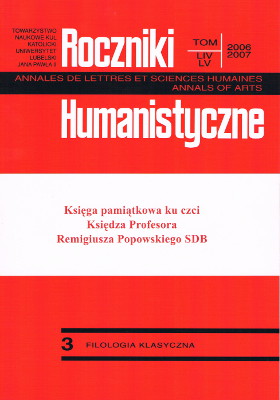Techniki obrazowania w poezji Sydoniusza Apollinarisa
Abstrakt
Sidonius’ poetic works, especially those more elaborated, in their structural dimension depict a mythological-ekphrastic composition, similar to so-called Alexandrian and neoteric epyllion. One notices here a spectacular dimension of poetry, typical of late antique aesthetics. This dimension is manifested in definite figurative techniques, especially the excessive use of mythological metaphor, together with numerous ekphrases. Their presence has from the very beginning been very meaningful in epic poetics; it was used to obtain one of the basic categories, the so-called aesthetics of the reception of a literary work – the impression of intuition of the presented plot (ἐνάργεια – evidentia). Decisively, the most interested examples of the application of mythological metaphor in the function of figurative techniques are found in Sidonius’ emperor’s panegyrics. They are related to the manner in which goddess Roma is presented, the goddess present in all three panegyrics. Its creation is most fully rendered by the allegorical message of mythological personification in the real-historical contents of the panegyrics. Each of the portraits of Roma reflects, by way of an allegory, Sidonius’ definite political intention and it is an artistic mode to present his personal political ideas.
Bibliografia
Bonjour M.: Sidonius Apollinaris inter Romanos et barbaros, „Acta Treverica” 1981, s. 109-113.
Bonjour M.: Personnification et prosopopée dans les ‘Panegyriques’ de Sidoine Apollinaire, „Vichiana” 11 (1982), s. 5-17.
Burck E.: Vom römischen Manierismus. Von der Dichtung der frühen römischen Kaiserzeit, Darmstadt: Wissenschaftliche Buchgesellschaft 1971. Reihe ‘Libelli’ 327.
Cameron A.: Poetae Novelli, „Harvard Studies in Classical Philology” 84 (1980), s. 127-175.
Castorina E.: I poetae novelli: contributo alla storia della cultura latina nel 2. secolo d. C., Firenze: La nuova Italia 1949.
Castorina E.: I poeti neoterici del IVo secolo, „Giornale italiano di filologia” 2 (1949), s. 117-146, 206-228.
Charlet J.-L.: Aesthetic Trends in Late Latin Poetry (325-410), „Philologus” 132 (1988), H. 1, s. 74-85.
Chianéa G.: Les idées politiques de Sidoine Apollinaire, „Revue historique de droit français et étranger” 47 (1969), no 3, s. 353-389.
Cizek A. N.: Imitatio et tractatio. Die literarisch-rhetorischen Grundagen der Nachahmung in Antike und Mittelalter, Tübingen: Niemeyer 1994.
Consolin o F. E.: Codice retorico e manierismo stilistico nella poetica di Sidonio Apollinare, „Annali della scuola normale superiore di Pisa”. Classe di lettere e filosofia, s. III, vol. IV, 1974, zwłaszcza s. 457 nn.
Curtius E. R.: Europäische Literatur und Lateinisches Mittelalter, Bern: A. Francke 19542.
Dörrie H.: Spätantike Symbolik und Allegorese, „Frühmittelalterliche Studien”. Jahrbuch des Instituts für Frühmittelforschung der Universität Münster 3 (1969), s. 1-12.
Drijepondt H. L.: Die antike Theorie der ‘varietas’. Dynamik und Wechsel im Auf und Ab als Charakteristikum von Stil und Struktur, Hildesheim–New York: G. Olms Verlag 1979. Spudasmata XXXVII.
Hahn R.: Die Allegorie in der antiken Rhetoric, Tübingen 1967.
Hofmann H.: Überlegungen zu einer Theorie der nichtchristlichen Epik der lateinischen Spätantike, „Philologus” 132 (1988), H. 1, s. 101-160.
Kirsch W.: Strukturwandel im lateinischen Epos des 4. bis 6. Jh., „Philologus” 123 (1979), s. 38-53.
Kurman J.: Ecphrases in Epic Poetry, „Comparative Literature” 7 (1974), s. 1-13.
Lawatsch-Boomgaarden B.: Die Kunstbeschreibung als strukturierendes Stilmittel in den Panegyriken des Claudius Claudianus, „Grazer Beiträge” 18 (1992), s. 171-193.
Loyen A.: Recherches historiques sur les Panégyriques de Sidoine Apollinaire, Paris: Champion 1942.
Loyen A.: Sidoine Apollinaire et l’esprit précieux en Gaule aux derniers jours de l’empire, Paris: Les Belles lettres 1943.
Marsili A.: Roma nella poesia di Claudiano. Romanità occidentale contraposta a quella orientale, „Antiquitas” 1, 2, (1946), s. 3-24.
Meidinger H.: Über die ‚variatio’ bei den römischen Dichter, Progr. Neuburg 1913.
Mythe et personnification. Actes du colloque du Grand Palais (Paris, 1977), éd. J. Duchemin, Paris: Les Belles lettres 1980.
Pépin J.: Mythe et allégorie. Les origines grecques et les contestations judéo-chrétiennes, Paris: Éditions Montaigne 1958.
Pépin J.: Dante et la tradition de l’allégorie, Paris: Vrin 1970.
Pernot L.: La rhétorique de l’éloge dans le monde gréco-romain, t. 1-2, Paris: Institute des Études Augustiniennes 1993. Collection des études augustniennes. Série Antiquité 137.
Ravenna G.: L’ekphrasis poetica di opere di arte in Latino: Temi e problemi, „Quaderni dell’Istituto di Filologia Latina dell’Università di Padova” 3 (1974), s. 1-52.
Roberts M.: The Jeweled Style. Poetry and Poetics in Late Antiquity, Ithaca–London: Cornell University Press 1989.
Ros J.: Die Metabole (variatio) als Stilprinzip des Tukidydes, Paderborn 1938.
Sánchez Salor E.: La última poesía latio-profana: su ambiente, „Estudios clásicos” 25 (1981-1983), s. 111-162.
Sandret L.: Sidoine Apollinaire historien, „Revue des questions historiques” 30 (1882), s. 210-224.
Sinko T.: De Horatii monstro ridiculo, (Commentationes Horatianae), Cracoviae 1958.
Styka J.: Fas et antiqua castitudo. Die Ästhetik der römischen Dichtung der republikanischen Epoche, Trier: Wissenschaftlicher Verlag 1995, s. 220-231. Bochumer Altertumswissenschaftliches Colloquium, Bd. 19.
Styka J.: Die Kategorie der Anmut in der Literaturtheorie und -kritik der Römer, [w:] Litteris vivere. Księga pamiątkowa ofiarowana Profesorowi Andrzejowi Wójcikowi, red. I. Lewandowski, K. Liman, Poznań: Wyd. UAM 1996, s. 83-95.
Styka J.: Decorum in Poetry: Horace’s ‘Ars poetica’, [w:] Studies of Greek and Roman Antiquity. Essays edited by Jerzy Styka, Kraków: Księgarnia Akademicka 1997, s. 47-69. Classica Cracoviensia III.
Styka J.: The Esthetics of Decorum in Roman Literature, Kraków: PAU 1997. Prace Komisji Filologii Klasycznej PAU 26.
Styka J.: ‘Convenientia Partium’: Harmony and Symmetry in Ancient Literary Esthetics, Kraków: PAU 1998. Prace Komisji Filologii Klasycznej PAU 27.
Styka J.: Die Poetik des Mythos bei Sidonius Apllinaris, [w:] The Myth in the Ancient Literature. Essays edited by J. Styka, Kraków: Księgarnia Akademicka 2002, s. 33-??. Classica Cracoviensia VII.
Sydoniusz Apolinary: Listy i wiersze, tłum. M. Brożek, Kraków: PAU 2004. Biblioteka Przekładów z Literatury Starożytnej nr 14.
Turasiewicz R.: Od ethosu do ethopoii. Studia z antycznej terminologii krytyczno-literackiej u Dionizjusza z Halikarnasu, Warszawa–Kraków: PWN 1975. Zeszyty Naukowe Uniwersytetu Jagiellońskiego CCCCII. Prace Historycznoliterackie, z. 32.
Copyright (c) 2007 Roczniki Humanistyczne

Utwór dostępny jest na licencji Creative Commons Uznanie autorstwa – Użycie niekomercyjne – Bez utworów zależnych 4.0 Międzynarodowe.





